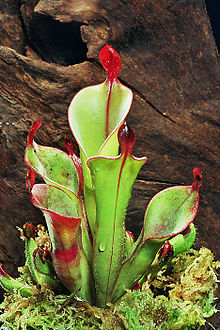| Heliamphora | |
|---|---|

| |
| Heliamphora chimantensis | |
| Scientific classification | |
| Kingdom: | Plantae |
| Clade: | Tracheophytes |
| Clade: | Angiosperms |
| Clade: | Eudicots |
| Clade: | Asterids |
| Order: | Ericales |
| Family: | Sarraceniaceae |
| Genus: | Heliamphora Benth. (1840) |

| |
| Heliamphora distribution | |
The genus Heliamphora (/hɛliˈæmfərə/ or /hiːliˈæmfərə/; Greek: helos "marsh" and amphoreus "amphora") contains 24 species of pitcher plants endemic to South America.[1] The species are collectively known as sun pitchers, based on the mistaken notion that the heli of Heliamphora is from the Greek helios, meaning "sun". The name instead derives from the Greek helos, meaning "marsh", so a more accurate translation of their scientific name would be marsh pitcher plants.[2] Species in the genus Heliamphora are carnivorous plants that consist of a modified leaf form that is fused into a tubular shape. They have evolved mechanisms to attract, trap, and kill insects; and control the amount of water in the pitcher. At least one species (H. tatei) produces its own proteolytic enzymes that allows it to digest its prey without the help of symbiotic bacteria.
- ^ McPherson, S., A. Wistuba, A. Fleischmann & J. Nerz 2011. Sarraceniaceae of South America. Redfern Natural History Productions, Poole.
- ^ Mellichamp, T.L. 1979. "The Correct Common Name for Heliamphora" (PDF). (196 KB) Carnivorous Plant Newsletter 8(3): 89.